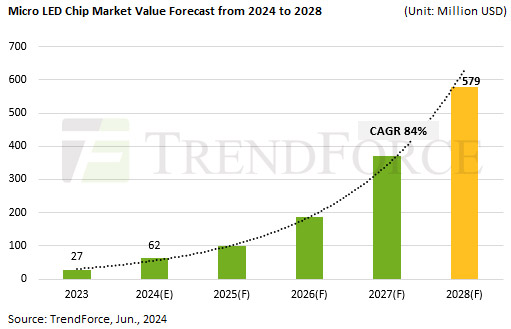News: Markets
4 June 2024
Micro-LED chip market growing at 84% CAGR to $579m by 2028
The micro-LED chip market is rising at a compound annual growth rate (CAGR) of 84% from just $27m in 2023 to $579m by 2028, forecasts TrendForce’s ‘2024 Micro LED Market Trend and Cost Analysis Report’.
With efforts to reduce the cost of micro-LED chips through size miniaturization ongoing, companies like LGE, BOE and Vistar continue to invest in large-display applications, while AUO has been focusing on developing smartwatch products. There is also growing demand for new display applications in head-mounted devices and for automotive uses.

Challenges in the micro-LED industry
The inability to reduce costs and technical challenges are major factors behind the cancellation of Apple’s micro-LED watch. Therefore, continuous optimization of production processes remains critical for the development of the micro-LED industry. The evolution of mass transfer technology is expected to shift from a single technique to a composite technique, such as combining laser transfer with stamp transfer and potentially achieving a transfer solution with bonding capability with no stiction.
Inspection and repair processes are critical for improving yield rates and reducing micro-LED costs. Existing electrical testing methods are being upgraded, focusing on high-precision probe cards and contactless testing. These advances are not only leading the development of electrical testing but also present significant business opportunities for equipment manufacturers.
The cancellation of the Apple Watch has prompted Germany-based chip supplier ams OSRAM to consider selling its 8-inch wafer fabrication plant in Malaysia. If the buyer is a company within the existing micro-LED supply chain, this could positively impact the industry’s technical development and cost structure optimization. Considering the shift in technology routes and target markets, Chinese compound semiconductor manufacturers developing 8-inch silicon carbide (SiC) power semiconductors are also potential buyers. This would allow them to expand into international markets, providing chip manufacturers with a means to increase profitability.
Opportunities in the micro-LED industry
Micro-LEDs still retain distinct advantages over competing technologies like micro-OLEDs. In augmented-reality (AR) glasses, which require light engines with high brightness and small volume, micro-LED light engines have now achieved sizes smaller than 0.2cc. With brightness levels advancing toward 350,000nits, micro-LEDs are well suited to high-brightness, all-weather and all-scene recognition. The rapid development of AI-assisted tools is also expected to drive demand for AR glasses with micro-LED displays over the next 1–2 years.
In the automotive sector, displays do not require extremely high levels of pixels per inch PPI but demand higher contrast and reliability. Due to its high brightness, contrast, wide color gamut and fast response, micro-LED technology can enhance the driving experience when integrated into smart cockpit display solutions with unique shapes, curves, flexibility and feedback. This expands the potential applications of micro-LEDs in automotive scenarios — such as AR-HUDs and P-HUDS — as well as innovative display technologies for car windows using transparent displays.
ams OSRAM re-assessing micro-LED strategy after Apple project cancelled
Micro-LED chip market to almost double to $27m in 2023, driven by large displays and wearables









